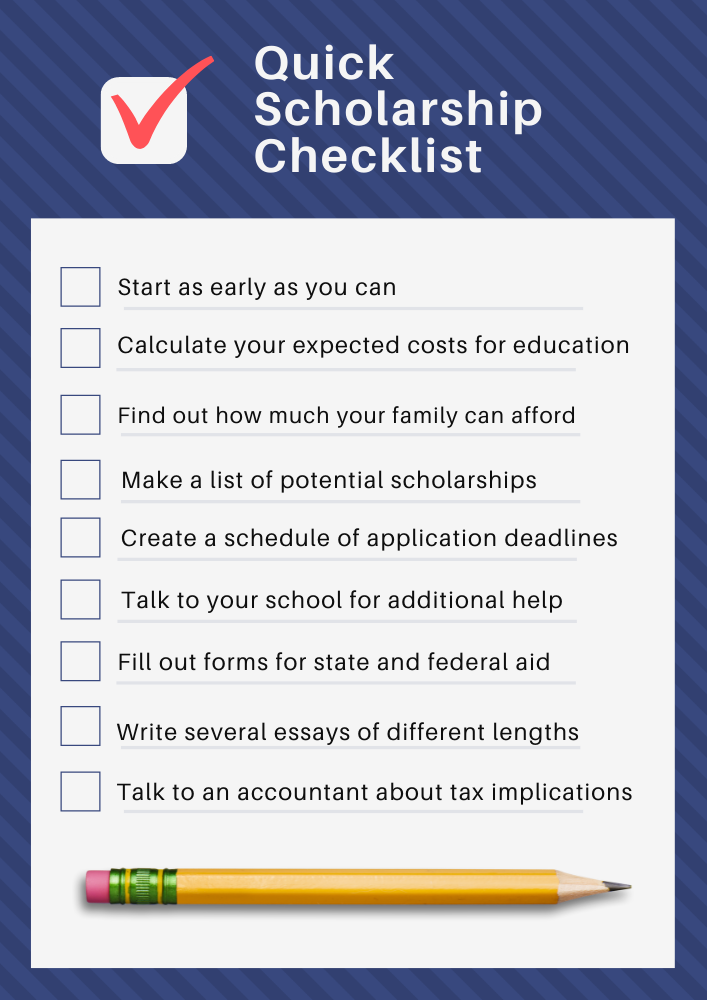When To Start Applying for Scholarships
Find your degree

One of the biggest questions prospective students have is, “when do i start applying for scholarships?” With college expenses on the rise, scholarships are more valuable than ever before. This form of financial aid is often your best route to an affordable college education. From full scholarships that cover the entire cost of your education to smaller awards, there are many opportunities for free money for college. Do you want to know how to apply for college scholarships while in high school? This guide has you covered.
The great news is that college scholarships are easy to apply for while you’re still in high school. Here’s everything you should know about them.
You may also like: Exploring Online College Scholarships
When To Start Applying for College Scholarships: Junior and Senior Years
So when should you start applying for college scholarships? The best time to start filling out scholarship applications is before senior year. Ideally, you should apply the summer after finishing your junior year. Some scholarships require at least a year of waiting before they are awarded. So completing scholarship applications before your senior year gives you time to go through the process and get the scholarship. However, if you’re already in your senior year, don’t worry. You can still find scholarships to apply for.
You can start applying for some scholarships before junior or senior year too. Earlier is generally better as long as you can meet the criteria. So younger students should not be timid about applying early.
Filling out scholarship applications can be intimidating if you don’t know what school you are going to. Make sure to look for scholarships that you can use at as many schools as possible. There is a popular misconception that millions of dollars in scholarships and financial aid go unclaimed every year. However, this is simply not true. In reality, almost all scholarships get claimed. And you can apply for as many scholarships as you want!
When Can I Start Applying for Scholarships?
Remember: Fall is scholarship season. And most deadlines fall between the months of October and December. Other people are trying to find scholarships too, so getting a head start helps maximize your chances of success. If you need help with your scholarship search, check with the financial aid office of the college you want to attend. You can also consult with your school counselor about the best scholarships for high school students. Current college students should be applying for financial aid and scholarship opportunities on an ongoing basis.

Preparing To Apply
When applying for scholarships, start by gathering all the necessary documents and materials. You’ll want to do this well in advance of the scholarship deadlines. In addition to the scholarship applications, you may also need:
Letters Of Recommendation
Many scholarships require a letter of recommendation. Recommendation letters highlight your academic achievements, personal qualities, and potential for success. It is usually best to choose someone who knows you well and can speak to your abilities and character. Make sure to allow enough time for the person you have asked to write the letter to complete it before the application deadline.
Essays
Some organizations that offer scholarships ask for essays. This helps them can get a better sense of who you are. It’s okay to ask for help with editing, but make sure you write scholarship essays yourself. Scholarship organizations want to understand you in your own words. Preparing several essays will save you a lot of time if you’re applying for dozens of scholarships. They have varying requirements, so consider writing scholarship essays that you can tweak as necessary.
Making A List Of Scholarships To Apply To
Creating a list of scholarships is an excellent way to compare the requirements to see where you can duplicate things and minimize work. Make sure you record information like the scholarship deadlines. This way, you don’t miss one opportunity while working on another. Staying organized during your scholarship search is vital. Once you’ve completed your list, you can start submitting your applications.
Making a list is also helpful for keeping track of which scholarships you’ve already applied to. Monitoring where you’ve applied and where you haven’t is crucial to maximizing your efficiency.

Types Of Scholarships
There are several types of scholarships and financial aid available. Some are easier to get than others. Know that you won’t be able to get many of these simply because you won’t meet the criteria. But don’t get discouraged during the scholarship process. There are so many scholarships out there that you’ll surely qualify for. With a little effort, you can make a huge dent in your college expenses.
Federal Grants
Federal scholarship grants are education awards offered by the federal government. They are a type of Federal student aid. This financial aid is given to students who meet specific eligibility criteria. These grants are awarded based on academic merit, financial need, or a combination of both. Grants do not need to be paid back, so they are basically free money.
Some of the most well-known federal scholarship grants include the Pell Grant, the FSEOG, and the National SMART Grant. The Pell Grant and FSEOG provide financial assistance to low-income undergraduate students. The National SMART Grant is merit-based. It provides financial assistance to students pursuing certain majors in STEM fields.
Tip: Don’t Forget About Federal Student Loans
If you’re struggling to find the money to pay for college, don’t forget about student loans. Several low-interest federal loan programs are available for qualifying applicants. These student loans aren’t scholarships because you’ll need to repay them, but they may offer better terms than private lenders can offer. You can find out more about this form of Federal student aid at your school’s financial aid office.
See also: How Does Financial Aid Work?
State Grants
State grants are available to residents who are attending college or university within their own states. Like Federal student aid, these are generally need-based, so families with fewer resources are more likely to qualify. However, the upper-income limit for these is relatively high, so it’s worth checking them to see if you are eligible.
States have widely varying criteria for grants and can offer scholarships and financial aid based on many factors. Some state grants are non-competitive and are typically easier to get.
Financial Need Scholarships
Financial need scholarships are specifically for students who need monetary help. Many state and federal programs fall under this category, but they aren’t the only groups that focus on applicants who need the most help. Notably, most universities have need-based scholarships, including Ivy League schools. Some schools can offer scholarships for up to 100% of your demonstrated financial need. In other words, if the school accepts you, the tuition costs won’t hold you back.
Scholarships from smaller schools and the government usually award lower amounts. These can range from several hundred to several thousand dollars a year. These various scholarships tend to be more competitive, so the more you can apply for, the better.
Negotiating Based On Financial Need
In some cases, you can get additional support based on your financial need by negotiating directly with the school. For example, if you got accepted to a prestigious school, you can use that as leverage to get support from a smaller (but more affordable) school. This is another reason to start applying for scholarships as soon as possible.
Academic/Merit Scholarships
Academic and merit scholarships depend on your performance in school or special competitions. Merit-based scholarships tend to be highly competitive. So you’ll want to apply for these scholarships early. The National Merit Scholarship Program is one of the most well-known names in this category, but it isn’t the only one. Many schools and private companies offer academic scholarships. These are also sometimes offered by religious organizations and city governments. If you want to study online, you can still get financial help. There are scholarships specifically for online college students.
High school seniors can often improve their chances of getting a merit-based scholarship. Getting good grades and staying active in the community can help. Taking advanced placement courses can also demonstrate you are motivated and ready to attend college.
Athletic Scholarships
Athletic scholarships are awarded to students who excel in a particular sport or sports. They must meet the eligibility criteria set by the NCAA or other athletic associations. The amount of scholarship money can vary depending on the sport, the athlete’s skill level, and the policies of the college or university.
Athletic scholarship recipients are expected to participate in their sport at a high level. They may also be subject to specific rules and regulations regarding their sport and their scholarship. These can include maintaining a certain GPA or meeting certain athletic performance standards.
Essay Scholarships
Essay scholarships are awarded to students who can write compelling essays. These scholarships have many types of selection criteria. Some are based only on your writing, while others consider financial needs and academic performance. Essay scholarships can have various requirements and prompts. These include writing about personal experiences, academic goals, community service, and other topics. The scholarship provider usually sets the word count and other formatting guidelines.
Essay scholarships are available from a variety of sources. They include private organizations, corporations, foundations, and universities. They can be awarded based on merit or need and can cover all or part of the cost of tuition, fees, books, and living expenses.

Field-Based Scholarships
Scholarships for specific industries are moderately challenging to get, but they tend to have high awards. Many of these are offered by schools and organizations to attract more applicants to an under-represented area. But you may have to do some digging. These are often scholarships nobody knows about.
Areas with such extreme needs are more likely to offer free money to attract qualified students. For example, there’s a significant shortage of nurses in the United States. Experts predict there will be more than a million openings for nurses soon. This means that nursing scholarships are often available. If you know what type of career you want to pursue, you can start applying for scholarships like this right away.
Military Support
Military scholarships help students who have a military connection to finance their education. They can be awarded to students who are active duty military members, veterans, or the children or spouses of military personnel. These scholarships can be offered by the military itself, by private organizations, or by schools. The scholarship amounts can vary widely, depending on the program and the student’s financial needs.
Some military scholarships are based on academic achievement, while others are based on need or merit. Many require applicants to maintain a certain GPA and commit to a certain number of years of military service after graduation.
Related: 20 Featured College Scholarships for Veterans
Special Group Scholarships
Special group scholarships offer assistance to people who meet specific demographic criteria. These can be easy or difficult to get, and the details are often out of your control. For example, this college funding may be awarded based on factors like gender, ethnicity, disabilities, or surviving cancer.
Unfortunately, these scholarships can be hard to find at times because schools don’t always advertise them. Consider every possibility, from living situation to ancestry, and search for private scholarships online to see if there’s a match. You might be surprised at how often you can find them.

Places To Find More Scholarships
Here are some of the best websites to go to for the best scholarship success.
Going Merry
Going Merry is a relatively new scholarship site, but it’s made a splash thanks to its excellent matching system and user-friendly process. This site focuses on local scholarships, auto-fills many forms, and even helps you apply for several scholarships at once. Time matters when you’re trying to maximize the number of awards you receive, so sites like this are a great way to find and apply for college scholarships.
Fastweb
Fastweb is a large scholarship site with a total of over 1.5 million scholarship opportunities. They verify each scholarship to ensure that it is legitimate. This way, you are not wasting your time applying for things you have little chance of winning. Fastweb also has a feature indicating which scholarships you’ve already applied for. That’s particularly useful when applying in bulk because it serves as a handy digital reference when using any other platform.
The College Board
The College Board is known for running the SAT program. However, it also has a wide selection of scholarships, financial aid, and internship opportunities. In total, the College Board offers over six billion dollars worth of aid. So it’s an excellent site to find scholarships. The College Board also stands out as one of the most reputable companies in the industry. They offer help for scholarships as part of their broader effort to promote college education across the country.
Scholarships.com
This website lists a considerable number of scholarships annually, making it another great place to look. They sort scholarships for applicants as early as high school freshmen, too, which can give you a particularly early start on applying.
Can Graduate Students Get Scholarships?
Absolutely! There are many scholarship opportunities specifically for graduate students. You can check all of the resources listed above. Plus, be sure to check with your school’s financial aid office to see what is available. And don’t forget, there are still plenty of forms of financial aid for current college students.
When Do You Start Applying for Scholarships as a Graduate Student?
Graduate students often want to know, “when should I start applying for college scholarships?” The best time to apply is when you decide to go to grad school. But you can still apply later on too. Some of the best colleges with scholarships offer excellent financial aid opportunities to promising graduate students.
Closing Thoughts On When To Start Applying for Scholarships
Scholarships are an excellent way to get an affordable education. You never have to pay them back, giving you peace of mind to concentrate on your studies. When can you start applying for scholarships? There are many scholarship opportunities out there. So it pays off to get started as early as possible. Start searching for scholarships in high school. The more prepared you are, the better your chances of getting the funds you need for your education. Good luck with your scholarship search!
See Also:
- Easy Scholarships! Quick College Cash
- The Complete College Planning Calendar
- A List of Scholarships For Attending Trade School
This concludes our article on when to apply for college scholarships.
OCP Staff
